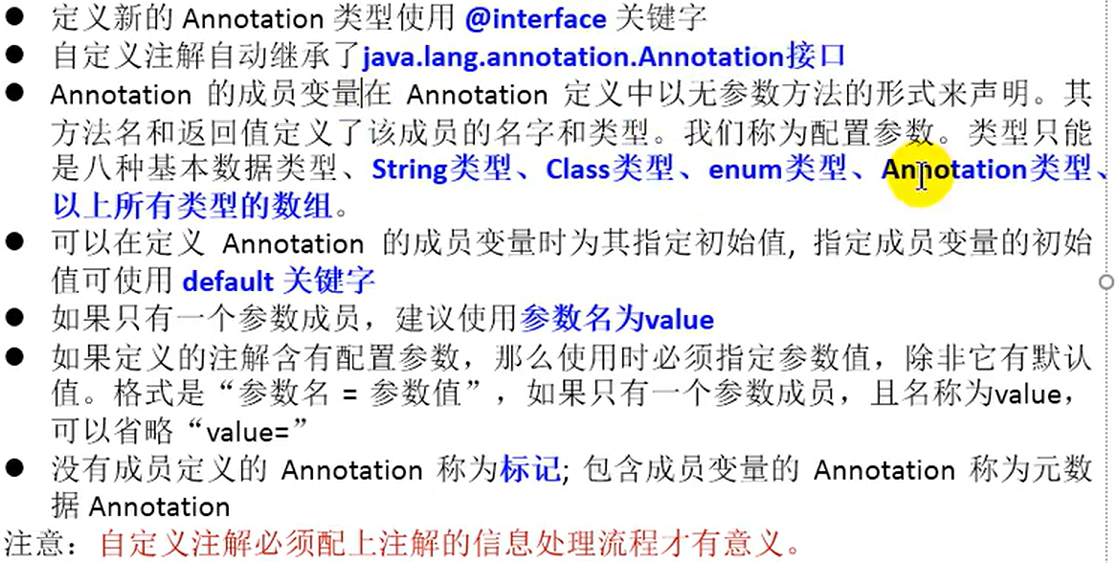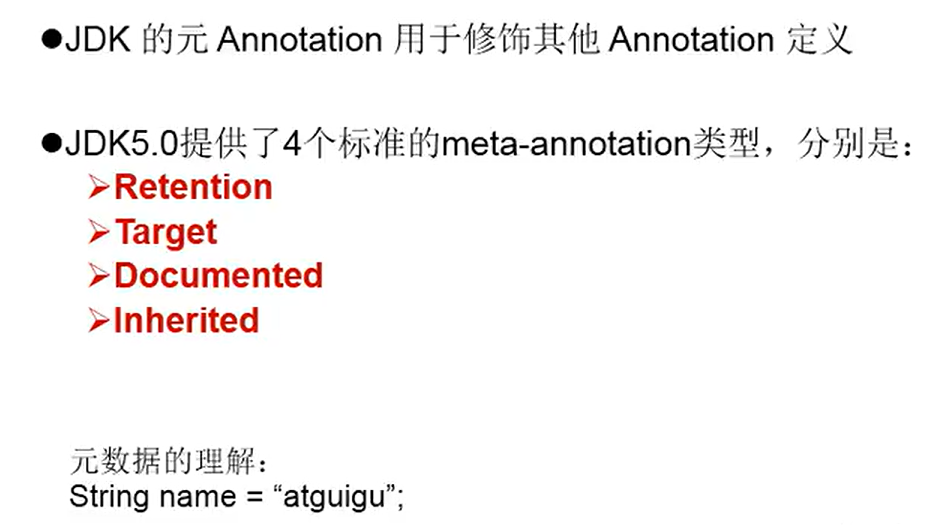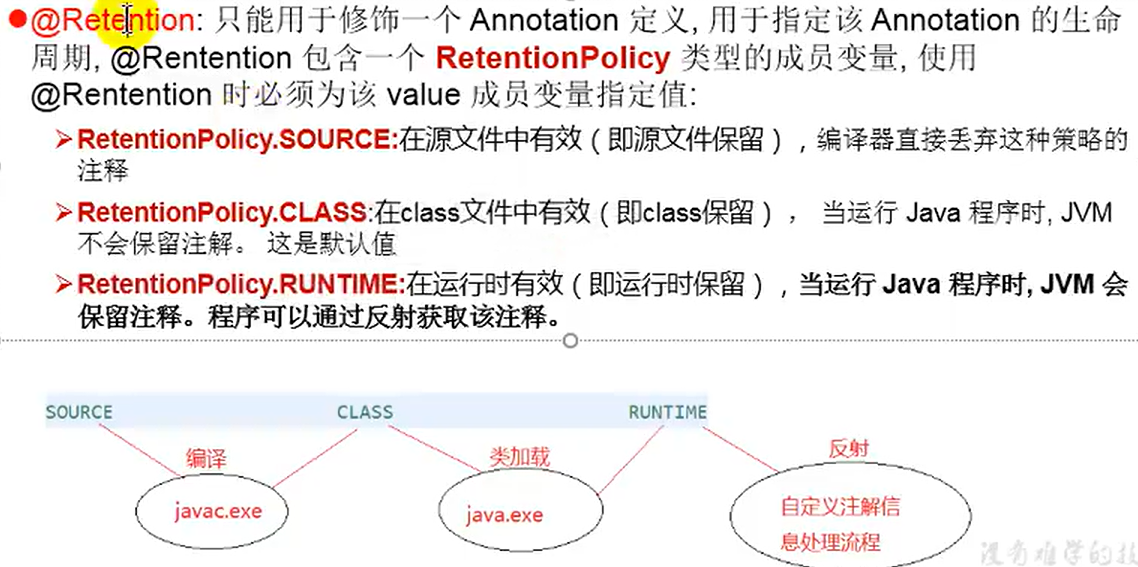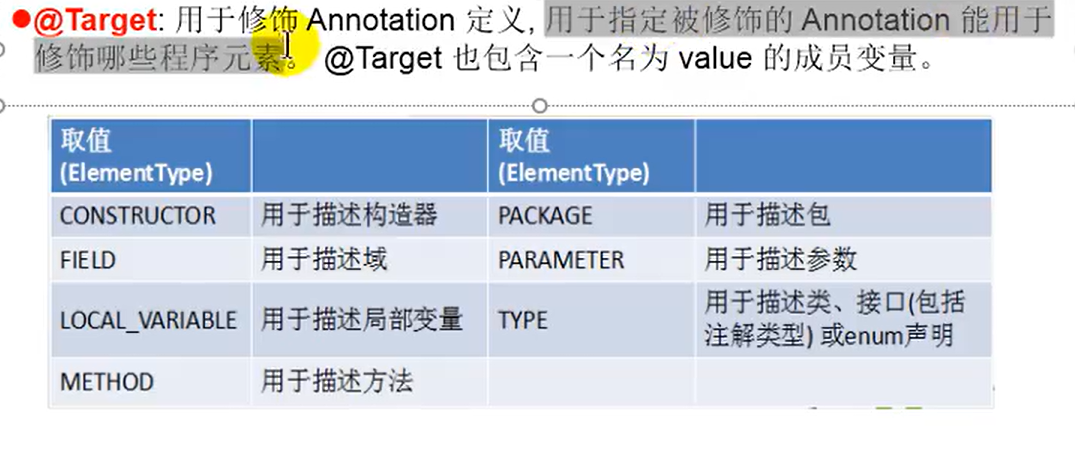1.Annocation的使用示例
示例一:生成文档相关的注解
示例二:在编译时进行格式检查(JDK内置的三个基本注解)
@Override:限定重写父类方法,该注解只能用于方法
@Deprecated:用于表示所修饰的元素(类,方法等)已过时
@SuppressWarnings:抑制编译器警告
2.自定义注解:


3.JDK中的元注解


4.例子
@Inherited @Repeatable(MyAnnotations.class) @Retention(RetentionPolicy.RUNTIME) @Target({TYPE, FIELD, METHOD, PARAMETER, CONSTRUCTOR, LOCAL_VARIABLE,TYPE_PARAMETER,TYPE_USE}) public @interface MyAnnotation { String value() default "hello"; }
@Inherited @Retention(RetentionPolicy.RUNTIME) @Target({TYPE, FIELD, METHOD, PARAMETER, CONSTRUCTOR, LOCAL_VARIABLE}) public @interface MyAnnotations { MyAnnotation[] value(); }
/** * 注解的使用 * * 1. 理解Annotation: * ① jdk 5.0 新增的功能 * * ② Annotation 其实就是代码里的特殊标记, 这些标记可以在编译, 类加载, 运行时被读取, 并执行相应的处理。通过使用 Annotation, * 程序员可以在不改变原有逻辑的情况下, 在源文件中嵌入一些补充信息。 * * ③在JavaSE中,注解的使用目的比较简单,例如标记过时的功能,忽略警告等。在JavaEE/Android * 中注解占据了更重要的角色,例如用来配置应用程序的任何切面,代替JavaEE旧版中所遗留的繁冗 * 代码和XML配置等。 * * 2. Annocation的使用示例 * 示例一:生成文档相关的注解 * 示例二:在编译时进行格式检查(JDK内置的三个基本注解) @Override: 限定重写父类方法, 该注解只能用于方法 @Deprecated: 用于表示所修饰的元素(类, 方法等)已过时。通常是因为所修饰的结构危险或存在更好的选择 @SuppressWarnings: 抑制编译器警告 * 示例三:跟踪代码依赖性,实现替代配置文件功能 * * 3. 如何自定义注解:参照@SuppressWarnings定义 * ① 注解声明为:@interface * ② 内部定义成员,通常使用value表示 * ③ 可以指定成员的默认值,使用default定义 * ④ 如果自定义注解没有成员,表明是一个标识作用。 如果注解有成员,在使用注解时,需要指明成员的值。 自定义注解必须配上注解的信息处理流程(使用反射)才有意义。 自定义注解通过都会指明两个元注解:Retention、Target 4. jdk 提供的4种元注解 元注解:对现有的注解进行解释说明的注解 Retention:指定所修饰的 Annotation 的生命周期:SOURCE\CLASS(默认行为)\RUNTIME 只有声明为RUNTIME生命周期的注解,才能通过反射获取。 Target:用于指定被修饰的 Annotation 能用于修饰哪些程序元素 *******出现的频率较低******* Documented:表示所修饰的注解在被javadoc解析时,保留下来。 Inherited:被它修饰的 Annotation 将具有继承性。 5.通过反射获取注解信息 ---到反射内容时系统讲解 6. jdk 8 中注解的新特性:可重复注解、类型注解 6.1 可重复注解:① 在MyAnnotation上声明@Repeatable,成员值为MyAnnotations.class ② MyAnnotation的Target和Retention等元注解与MyAnnotations相同。 6.2 类型注解: ElementType.TYPE_PARAMETER 表示该注解能写在类型变量的声明语句中(如:泛型声明)。 ElementType.TYPE_USE 表示该注解能写在使用类型的任何语句中。 * * @author shkstart * @create 2019 上午 11:37 */ public class AnnotationTest { public static void main(String[] args) { Person p = new Student(); p.walk(); Date date = new Date(2020, 10, 11); System.out.println(date); @SuppressWarnings("unused") int num = 10; // System.out.println(num); @SuppressWarnings({ "unused", "rawtypes" }) ArrayList list = new ArrayList(); } @Test public void testGetAnnotation(){ Class clazz = Student.class; Annotation[] annotations = clazz.getAnnotations(); for(int i = 0;i < annotations.length;i++){ System.out.println(annotations[i]); } } } //jdk 8之前的写法: //@MyAnnotations({@MyAnnotation(value="hi"),@MyAnnotation(value="hi")}) @MyAnnotation(value="hi") @MyAnnotation(value="abc") class Person{ private String name; private int age; public Person() { } @MyAnnotation public Person(String name, int age) { this.name = name; this.age = age; } @MyAnnotation public void walk(){ System.out.println("人走路"); } public void eat(){ System.out.println("人吃饭"); } } interface Info{ void show(); } class Student extends Person implements Info{ @Override public void walk() { System.out.println("学生走路"); } public void show() { } } class Generic<@MyAnnotation T>{ public void show() throws @MyAnnotation RuntimeException{ ArrayList<@MyAnnotation String> list = new ArrayList<>(); int num = (@MyAnnotation int) 10L; } }